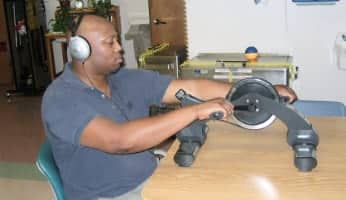Eileen’s Focus and Confidence Boost: IM’s Role in Handwriting and Schoolwork Improvement

Home - Testimonials - Pediatric Testimonials - Eileen’s Focus and Confidence Boost: IM’s Role in Handwriting and Schoolwork Improvement

Eileen’s Focus and Confidence Boost: IM’s Role in Handwriting and Schoolwork Improvement
Eileen, a 7 year old girl, was referred to Occupational Therapy by an Audiologist who had been seeing her for hearing loss in her right ear. The Audiologist came to me asking “Can you tell me more about this IM stuff?”
Eileen had been given some central auditory processing testing during her latest appointment, and she had failed it miserably. Eileen’s mom came to the first evaluation requesting IM for her daughter from the very beginning.
Initial Evaluation
When I met Eileen I noticed that she not only had difficulty following directions (asking for them to be repeated, needing visual demonstrations) but she also was very awkward, had difficulty motor planning how to move her body, difficulty with fine motor skills and overall lower than average strength and muscle tone.
She was big for her age and would accidentally knock other children over on the playground.
Her teachers were getting annoyed that she was talking too much in class and that she was starting to fall behind the other children in material that included new concepts such as math and reading. Homework in the evening was a nightmare for the family.
Eileen would refuse to participate, cry and have temper tantrums.
Her mom thought she just wasn’t listening very well and they would have to call her name or tell her directions repeatedly before she would respond.
Standardized Evaluation
When Eileen was evaluated in our Occupational Therapy department other standardized tools were utilized in addition to the Long Form Assessment of the IM program. As you could guess, Eileen came out with delays in many areas. Her visual perceptual skills were at a 5 year old level (MVPT) and visual motor skills at a 6 year old level (VMI).
The Bruininks subtests were very difficult for Eileen to complete with her scoring below average in fine motor precision, fine motor integration and bilateral coordination. She scored well below average in manual dexterity.
Her ability to copy words and short sentences was poor as she would skip letters and words.
She was very disorganized and had poor body awareness – sensory strategies were also evaluated and utilized.
Starting OT Sessions
At first Eileen participated in several “typical” OT sessions. We worked on improving self regulation, improving body awareness and fine motor skills. She was very unmotivated to sit at a table and perform any fine motor tasks.
She continued to struggle at school and her deficits were also spilling over into community activities such as dance class and Girl Scouts.
It was reported that her attention for these things was fleeting and she would just stare off into space frequently.
Introduction of IM in Sessions
On her first visit using the IM we performed a Long Form Assessment to get a baseline which we would use to measure any developments. I find this very helpful in showing progress over time. Since she was hearing impaired in her right ear we used computer speakers for her to hear the IM sounds.
Eileen’s overall unadjusted score was 333ms – in the Extreme Deficiency range for her age.
She really struggled performing all of the exercises with IM. Even her hand clapping was ballistic and erratic. She almost fell over several times when performing the lower extremity exercises.
Her mother watched in amazement as Eileen struggled with such things as tapping one foot or stepping backwards.
Her scores reflected great differences in left and right and upper and lower body performance. It was as if she was divided into 4 quadrants – no wonder her coordination was so poor.
I described it to mom as a car trying to drive a straight line when all 4 wheels were going at different speeds.
Eileen came 2x/week for 60 minute sessions. Many days she was just exhausted after 45 minutes. Mom said she would fall asleep on the way home from her therapy sessions.
Adapting IM to Eileen’s Specific Needs
We had to make many adaptations to try to help Eileen match the IM reference beat. I would put the switches on my hands and we would do pat-a-cake together – I would adjust my movement to help her learn how to hit the switch on the beat.
We also found that exercises which required either a very small simple movement such as tapping a micro switch with her finger tip or larger movements such as hitting switches which were farther apart and hung on the Velcro wall were the simplest for her.
Directions were kept very simple and sensory supports were given during the exercises such as allowing her to chew gum, bounce on the therapy ball or have a drink of water.
We went on for 5 sessions without much progress made. But then on our 6th visit we had an “Ah-ha” moment.
The “Ah-ha” Breakthrough
Eileen was sitting on a therapy ball, lights off in the room (she had terrible visual attention) and clapping and she noticed that she got a “green one” (Super Right On hit) and then another and another – she became very focused and actually started to adjust her timing (slowing down) to get with the beat.
This was a wonderful moment for her! She was very proud to announce to her mom that she had gotten “Bursts” (a series of Super Right On hits) that day as there was a reward system set in place when she would meet a predetermined goal.
Rewards were a huge part of Eileen’s compliance with the program. Eileen’s mom had purchased a special locket necklace for her and she could earn a charm to put into the locket each week. In order to earn a charm, she had to beat 50% of her scores from the prior session.
She was also motivated to earn a sticker for each Burst that she achieved and could then cash them in for added time on the playground or a trip to our hospital gift shop.
We also allowed her to chew gum to provide proprioceptive input (sometimes she would choose 3 pieces of double bubble at one time).
Improvements at School and Home
After Eileen’s 9th visit, her mom told me that they were seeing great improvement at school. She was performing remarkably better in her math class. Homework was not an issue at home anymore as Eileen would come home and want to get it done so she could play.
She was becoming more active at home as well and instead of lying on the couch watching TV she would go outside and play. She was acting much more age appropriate at family gatherings and community activities. Tantrums were becoming fewer and farther apart.
Friendships were forming in her classroom and at church and she was beginning to have play dates with other children her age.
We continued to see improvement over the next 21 visits. At first her Burst level was set at 2, then 3 and finally 4. She worked very hard at beating her millisecond scores as well.
I really learned a lot about functional attention during her sessions. Initially she would constantly be looking around the room so we tried turning the lights off in the room and she was able to focus better.
She had a hard time standing in one spot without jumping around so we had her stand on a balance board or an aerobics bench to give her boundaries of where to put her feet. We noticed that when she was performing a longer task (1000 repetitions) that if just one little thing caught her eye she would lose focus for at least 30 seconds before she was able to regain it – think about how much information she was missing in the classroom each time she was distracted!
It was wonderful to see her progress.
I began adding extra noises in the room by singing a song or asking Eileen her spelling words during tasks and she slowly but surely rose to the occasion.
At the end of our time together, Eileen showed an overall improvement of 82.5% according to the IM program.
Her unadjusted score on the LFA was 57 MS which was above average for her age.
Her ability to get “Super Right Ons” showed a change of 1400% from the initial assessment!
There was still a slight difference in her upper and lower body scores, but her right/left scores were now very similar.
She was able to achieve a score of 27MS on her “Attend Over Time Test (which she could not even perform during her initial assessment).
It was also amazing that her handwriting and schoolwork improved greatly as she learned to focus and process the information that people were telling her.
She now loves arts and crafts activities and did well selling Girl Scout cookies this year. She was ready to move on to more community based physical activities and expressed an interest in swimming and dance class.
Her school performance improved greatly and she did well on state testing this year. Teachers no longer have issues with Eileen, and she seems to have made several good friends on the playground.
She is a much happier little girl who can now process, attend and interact with her environment.
Wendy Harron, OTR/L
Alfred I. duPont Hospital for Children
Wilmington, DE




